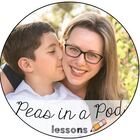Welcome to our book study of The Reading Strategies Book: Your Everything Guide to Developing Skilled Readers by Jennifer Serravallo! I am joining forces with some other fabulous teacher bloggers to discuss the reading strategies we come across in this AMAZING professional text! If you missed my first post about this book study, you can find it here, along with a suggested way to set up your book for easy reference.
You can also find my thoughts and ideas on other goals in this book below:
Goal 1: Supporting Pre-Emergent and Emergent Readers
Goal 2: Reading Engagement
Goal 3: Supporting Print Work
Goal 4: Fluency
Goal 5: Supporting Comprehension in Fiction Main Idea and Plot
Goal 6: Supporting Comprehension in Fiction Characters
Goal 7: Supporting Comprehension in Fiction Theme
Goal 8: Supporting Comprehension in Non-Fiction : Main Idea
Goal 9: Supporting Comprehension in Non-Fiction - Key Details
Goal 10 : Supporting Comprehension in Non-Fiction - Text Features
Goal 11: Understanding Vocabulary and Figurative Language
Goal 12: Speaking, Listening, and Deepening Comprehension
Writing about reading incorporates both the thinking readers do as they read and the ability to write a piece that captures and furthers their thinking. Many students don't realize that readers need to think deeply about the text. We need to teach these students that thinking about what we are reading matters.
Serravallo warns that teachers need to be careful that when we assign written responses to students, that the writing about reading doesn't overtake the enjoyment of reading. She suggests offering readers the choice of when and how to respond.
Most of the strategies in this section are geared more towards upper elementary and middle school grades. Serravallo says that this is because writing about reading in the younger grades can take so long, that she questions whether it is worth the time. She believes that younger students need to focus on reading a lot, strengthening their print work, fluency, and comprehension.
When choosing this as a goal for your students to work on, you may want to consider students who:
* have greater oral expression of their comprehension than their ability to articulate their ideas in writing.
* may be able to use writing as a tool to support their comprehension. This may be especially true for students who may have a hard time remembering what they read without written notes.
* have strong writing abilities, but who show superficial thinking in their responses to reading.
Focus Strategy 1: Quick Stops Using Symbols
This strategy is one that students can use as they are reading when they don't want to stop reading to take notes, but they want to remind themselves to come back to take notes. As they read, they can use a quick think mark symbol to note their thought. They can come back to this page and ask themselves, "What was the thought I was having on this page?" You can create an anchor chart like the ones below to teach students common symbols and what they mean.

Focus Strategy 2: Buying Stock In Sticky Notes
I really just love the title of this strategy, because I often feel like I need to buy stock in sticky notes for my classroom! I also love this strategy because it was one that I used as a student in high school when I didn't own the book but I wanted to keep track of my thinking.
This strategy encourages students to make use of sticky notes to document their thinking. Serravallo suggest students prompt themselves as they read and have thoughts about what they are reading, "If I write this down, will it help me read better? Talk to my reading partner better? Help me talk to my teacher about what I am reading? If the answer is yes, they should write it down!
Focus Strategy 3: Five Sentence Summary
I chose this strategy because my students often have difficulty writing summaries. Research shows that one of the best ways to understand what you read is by summarizing it. So... needless to say, this is an important skill.
You can model this strategy on your hand, telling students to think of the 5 most important events in the story and to say them out loud in order using each of your 5 fingers. The students should then write out each of these events using one sentence per event.
Remember, we are only picking and choosing some of the strategies to share with you - there are so many more great ones in this section as well as the rest of the book!
If you would like to purchase the book mentioned above, you can find it here.
This post contains affiliate links. I earn a small commission each time someone makes a purchase using one of my links, which helps to support the blog. All opinions are my own and I only promote brands and products that I have used myself and truly love.
Katie from Resources by Roltgen is officially hosting goal 13 over at her blog, so make sure you head over there to see which strategies she chose to share! While you are there, be sure to leave some comment love!

If you would like to link up your own blog posts about this book, feel free to do so in the linky below!


























